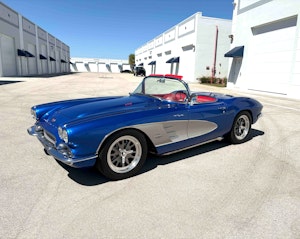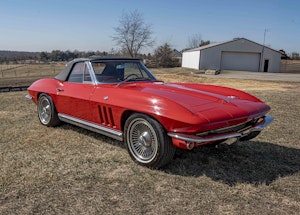Media | Articles
Quail 2018: The day the 1980s became legitimate
Although we spent the day wandering the same car show, my esteemed colleague Brett Berk and I came away from this year’s Quail Motorsports Gathering with two distinctly different impressions. For him, it was a rote assembly of auto icons that had largely been seen before, presented alongside a gilded trough of exquisite eats, albeit with the usual chronic shortage of shaded seating. And while I can’t argue that many of the Quail’s cars were been-there, seen-thats, and it probably pandered a bit too much to the new-supercar crowd, for me this was the event that I will always remember as the day the 1980s hit the big time.
Anybody who has been to the Monterey weekend over the past 30 years knows that its reverence for the post-war era starts in 1945 and stops dead around 1975, when regulations began to besmirch car design and choke out horsepower. Everything on the road thereafter was the outcome of compliance rather than passion, goes the thinking, and Monterey has dug a pretty deep moat to keep out modern times as the same 30 years is celebrated over and over (and over).
Well, I came of age in the 1980s, long after the party was supposedly over, and this year the Quail had several items that were electrifying for people of my generation. Not that you couldn’t find 1980s Porsches and Benzes out on the streets or at some of the ancillary shows before, or that cheese-grater Testarossas and winged-wonder Countaches weren’t already a staple of the Concorso Italiano. But now the 1980s has made it to the number two show of the weekend, the glittering K2 of Monterey, the Quail.

Let’s start with Floridian John Campion’s gobsmacking collection of 1980s Lancia racing icons. It begins with his 1981 Lancia Beta Montecarlo Turbo, a lascivious slab of muscle and glower that won its class at Le Mans, and ends with his 1988 Lancia Delta HF Integrale, a hatchback lunchbox that nonetheless as a Group A rally car won the 1988 World Rally Championship. Italian booze brand Martini & Rossi was founded in 1863, long before somebody thought to paste the name on a car, but somehow the brand’s trademark swoosh of blue and red made the perfect racing scheme in the 1980s.
Marketplace
Buy and sell classics with confidence
All of Campion’s cars wear Martini colors, including the lovely Lancia LC1 and LC2 sports prototypes that campaigned at Le Mans and elsewhere, and the 1983 Lancia O37 mid-engine rally rocket, by far the sexiest of the Group B specials. Lift the mammoth yet featherweight rear hatch of Campion’s 1985 Lancia Delta S4, the all-wheel-drive mid-engine monster that ultimately killed Group B by proving to be too powerful for public roads, and there is one of the most sophisticated racing engines of its day: a 1.8-liter four cylinder feeding from both a turbocharger and a supercharger to make over 500 horsepower.
Seeing them all lined up there in front of the Quail stage, I now get why baby boomers went weak-kneed being close to Denny Hulme’s McLaren M6B Can-Am car, and their dads swooned over seeing a Cunningham C2 or A.K. Miller’s Caballo II, and their grandads got giddy around a Mercer Raceabout. Campion’s Martini heartthrobs are the gods I worshipped as a kid, and they are now having their moment.


Moving on, I’m not sure how many people over the age of 50 got the joke when Dean Lanzante clumped onto the Quail green in what looked like an ordinary but highly polished Volkswagen Beetle dune buggy on huge sand-paddle rear tires. But I got it instantly, and it was one of the best things I saw all weekend. Lanzante, of the United Kingdom, has constructed a perfect 1:1 scale replica of the Tamiya Sand Scorcher, one of the world’s first radio-control off-road toy buggies. Thousands came after, but the 1/10th-scale Sand Scorcher was present at the creation of a hobby, featured in all the magazines when it debuted in December 1979. Tamiya’s own ads showed it flying in the air and plowing through mud and water as if winning a miniature Baja 1000, and the Sand Scorcher became an instant object of lust for an entire generation of Boys’ Life readers. I wanted one so indescribably badly—and exactly in that blue-and-white racing scheme that appeared on the large white box the kit originally came in.
Apparently, so did Lanzante because he also built a perfect replica of an Acons radio-control handset to display with the car. The faux R/C unit is about five feet tall and in perfect scale with the car. Blink and you’re back in a dirt lot behind the old house, about to lay tiny tracks with your Tamiya buggy that will launch a radio-control revolution. Yeah, it’s obscure and esoteric, but only if you weren’t a kid in the early ’80s.



Also on the grass at Quail were a few other items of boyhood lust, including Dick Caradori’s 1977 Italy Car Ferrari 312 T2 go-kart. Shrunk down to pint size but highly detailed and drivable (if you’re 3–4 feet tall), the mini-Ferrari was produced by a company called Italy Car, which managed to squeeze out just 12 of the planned 100 copies before Ferrari’s lawyers swooped in and shut it down. Powered by a bespoke 50cc two-stroke engine running through a two-speed transmission, the wee 312 has a beautifully crafted A-arm suspension that closely mimics the real car, a raft of correct-looking gauges behind a tiny, genuine leather-wrapped Momo steering wheel, disc brakes, and a body that gets pretty right all the proportions of Niki Lauda’s world championship car. I remember reading about these as a kid and being so jealous of the lucky junior F1 pilot pictured at the wheel. Caradori displayed the car, which he bought for the then-astounding sum of $8000 back in the mid-1980s, and which is now worth about $100,000, in front of a photo of his son driving it 30 years ago. Now his seven-year-old grandson gets to drive it, though Caradori acknowledges that it might be less risky to buy the little boy a brand-new Mercedes-Benz to tool around in.
More ’80s Ferrari oddness was found across the way in the Ferrari ring, where the 1980 Ferrari Pinin concept car was on display. Those who remember the first and only four-door Ferrari (so far) will recall a sleek and angular sedan proposal from Pininfarina that was in the mode of a stretched Ferrari 400i. Besides being the only four-door Cavallino yet made, the silver limo is also the only Ferrari to put the company’s 5.0-liter flat-12 boxer engine up front. Under the hood the car looks like a Subaru on steroids, and it thus has very abbreviated turn angles for the front wheels and a ridiculously large turning radius as a result of the wide engine. Then again, it wasn’t really meant to be driven, having neither air conditioning nor roll-down windows. But if Ferrari never did build it, the Pinin presaged the future by featuring digital gauges and a computer screen for back-seat riders.



Not too far from the Pinin sat a real live Dome-0, a car most people couldn’t name on a bet but which, if you were an avid collector of toy cars back in the early Reagan years, should definitely be familiar. Japan’s answer to the wedge warriors from Europe such as the Countach and Alfa Romeo Carabo, the Dome-0 (say “dome-zero”) was a misfired attempt to market a Japanese low-volume sports car. The initial prototype at the Quail first appeared at the 1978 Geneva auto show running a mid-mounted Datsun 280Z six-cylinder in a body just 38.6 inches high. It was probably the last, best example of the hyper-wedge idea so pervasive in the 1970s, and while just two prototypes and a couple of Le Mans racers were built, the car was immortalized in a million variations of diecast and plastic model replicas.
After it left this year’s Quail, the Dome-0 joined a host of other Japanese historic vehicles in their own palatial display across the street from the Lodge where the storied Pebble Beach Concours d’Elegance happens. This year at Monterey, Japanese cars and newer cars in general were having their unofficial coming out party, nouveaux barbarians crossing the moat around Monterey and being recognized as vehicles worth celebrating in their own right. As the clock spins and new generations pilgrimage to the Monterey Peninsula in August to indulge their car passions, this year’s Quail may come to be seen as the time and place where the 1980s officially became legit.





















